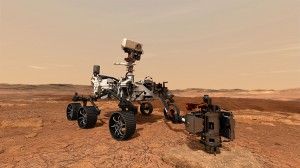Perseverance and Friends Make It to Mars
Friday, February 19th, 2021Mars is one of the most difficult destinations to arrive safely at in the solar system, but you might not know it if you have been paying attention to the news lately. Earthlings are a perfect three-for-three on Mars missions this February. Two countries saw their first missions ever arrive at the Red Planet last week. Then yesterday, the United States National Aeronautics and Space Administration (NASA) landed the Mars 2020 rover Perseverance on the surface of Mars. This flotilla of missions to the Red Planet was facilitated by a favorable alignment in the middle of 2020 that brought the planet close to Earth.
On February 9, a spacecraft from the United Arab Emirates (UAE) arrived in orbit around Mars. The orbiter, called Hope or Amal, will map Martian weather on a planet-wide scale. Such mapping has never been attempted before. UAE became just the fifth country to reach the planet. All systems look good at the moment, but Hope is due to enter the orbit from which it will conduct its mapping in May. At that point, engineers will know for sure if the probe will be able to accomplish its mission.
Hot on Hope’s heels was an ambitious mission sent by the China National Space Administration (CNSA). The mission, called Tianwen-1, went into orbit around Mars the next day. The mission consists of an orbiter, a lander, and a rover. The lander and rover will attempt a landing in a few months. If CNSA successfully deploys Tianwen-1, China will become the third country to land a spacecraft on Mars and just the second to land a rover on Mars.
The last—but certainly not least—to arrive was Perseverance. The rocket carrying the beefy rover blasted off from Cape Canaveral in Florida on July, 30, 2020. Perseverance is the largest rover ever sent to Mars. It’s the size of a small automobile and weighs over 2,200 pounds (1,000 kilograms) on Earth.
Unlike China and the UAE, the United States is a Mars veteran. NASA has landed several successful missions there, including the still-operational sibling craft of Perseverance, the Mars Science Laboratory (MSL) rover Curiosity.
The design of Perseverance is based on that of Curiosity, which has been exploring Mars since 2012. Engineers used many extra components that were originally created as backups for Curiosity in case of manufacturing defects in the originals. But Perseverance is more than just a pile of spare parts. Jet Propulsion Laboratory (JPL) scientists and engineers modified—and beefed up—the design to fit Perseverance’s mission. Perseverance is about 5 inches (13 centimeters) longer and 278 pounds (126 kilograms) heavier than Curiosity.
No matter how many successful missions are under a space agency’s belt, getting a spacecraft to Mars is a heart-pounding ordeal. Landing on the Red Planet is especially challenging. Mars is a large planet, so its gravity pulls spacecraft towards it at high speed. It lacks a thick atmosphere like that of Earth, however, that spacecraft could use to slow down. Furthermore, retrorockets placed on the rover would scour the ground near the landing site and contaminate it with rocket exhaust.
JPL has developed a complex of system to land a large rover on the Martian surface, which was first used with MSL. A parachute slowed the craft after it entered the Martian atmosphere. A set of rockets then fired to hover the craft above the surface. Then, Perseverance was lowered to the ground on a tether. Mission planners call this complicated ride through the atmosphere, filled with opportunities for mission-ending disaster, “the seven minutes of terror.”
Perseverance touched down in Jezero Crater. Billions of years ago, the crater held a lake that was fed by a river system. Perseverance will explore this ancient river delta and search for signs of past life there.
Perseverance carries many sophisticated scientific instruments that will enable it study the geology and climate of the region. The rover is equipped with a special drill and sample vials. After studying the rock samples it has drilled, it will place them in sealed vials and cache (stow) them on the surface. Scientists hope to recover the cached vials and send them to Earth in an ambitious sample return mission in a decade or so.
Other special features included an upgraded autonomous driving package, which will enable Perseverance to pick its way through obstacles on its own to reach a target, and a small helicopter drone called Ingenuity that will look to demonstrate the first powered flight on a solar system body other than Earth. Expect to hear about more exciting discoveries—and see more stunning pictures of Mars—in the months and years ahead.




